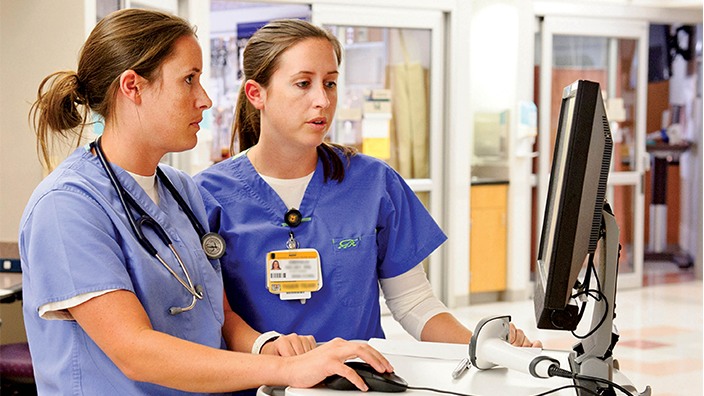In 2010, Cerner Corporation developed the St. John Sepsis Surveillance Agent in an effort to identify sepsis at its earliest stages. The agent has been implemented in more than 550 hospitals in the United States alone and has proven to be an effective tool for early identification of high-risk patients.
Of the more than 1.5 million Americans who are affected by sepsis each year, 250,000 die from the infection response. In fact, one in three patients who die in hospitals have sepsis. Early detection is critical to treating the disease and saving lives. Here are three stories of how sepsis surveillance has impacted the way health care is delivered by identifying and intervening with the disease.
Early detection to reduce mortality rates
Although they were regularly monitoring patients for symptoms of sepsis, physicians and nurses at Middlesex Hospital in Middletown, Connecticut, were not receiving consistent, timely or accurate data measurements. In 2013, the hospital measured an annual sepsis mortality rate of 7.5 percent - well below the Connecticut state mean of 13.4 percent, but they had room for improvement.
After adopting a sepsis surveillance agent, Middlesex saw its average annual sepsis mortality rate drop from 7.5 percent in 2013 to 5.6 percent in 2014. Readmission rates for people with sepsis went down and length of stay for this group also decreased. Additionally, the hospital's Rapid Response Team was able to transfer individuals to a higher level of care because their risk for sepsis was being identified at a much earlier point in the process.
Middlesex Hospital ultimately received the Connecticut Hospital Association John D. Thompson Award for Excellence in the Delivery of Healthcare through the Use of Data.
"My hat's off to all of the people at the organization that really worked hard to make this happen. Our patients and our community are the people that really benefit from it, and it's great to see, and it's great to be part of that." - Vincent G. Capece Jr., president and CEO at Middlesex Hospital
Read More: Middlesex Hospital reduces sepsis mortality rate by 25 percent using St. John Sepsis agent
Adjusting sepsis workflow to improve outcomes
Yavapai Regional Medical Center (YRMC), a 206-bed, nonprofit community health system in Prescott, Arizona, saw an opportunity to improve its quality reporting by automating its documentation processes. It implemented an automated and intelligent workforce management solution that reviewed and adjusted the organization's sepsis workflow, incorporating a sepsis surveillance agent that provided an open chart alert that was reflected within the patient record. This change led to an increase from 50 to 85 percent in the ordering and collection of repeat lactate test results (if the initial lactate is greater than two).
During its implementation in May 2016, YRMC providers and nurses were trained to provide time-efficient documentation, and in the following year, the hospital system saw a 210 percent increase in the percentage of physicians performing documentation on a suspected source of infection.
"Trying to connect all the pieces for this extremely complicated measure, including modifications to the standard recommendations to adapt to our provider's preferences and workflow, would have been impossible without the help [from the Cerner quality reporting team]." - Vickie Jones, RN, clinical quality analyst, meaningful use coordinator at YRMC
Read More: Community health system staff experience better workflow with elbow-to-elbow training
Helping the hospital's bottom line
Before adopting a targeted surveillance agent, sepsis was the leading cause of mortality at Lafayette General Health, with an overall sepsis mortality rate of 16.5 percent. Leaders at the Lafayette, Louisiana, hospital sought to get on the forefront of the issue to reduce the mortality rate and improve quality measure compliance, and in the process, they also positively impacted their bottom line.
Lafayette first integrated a sepsis surveillance agent within its electronic health record. Leaders also appointed a sepsis response nurse to complete assessments with patients before contacting physicians. This new position provided immediate treatment, helping to stop the progression of sepsis in at-risk patients. Lafayette also upgraded electronic documentation processes to improve its quality measure compliance by 949 percent. The hospital saw its mortality rate drop to less than 13 percent after these changes, which equates to an average of more than three lives saved each month from sepsis.
Earlier diagnoses impact prognoses and increasing efficiencies and costs for both the hospital and the patient. These improved outcomes not only had a profound impact on the lives others, but it also had a financial effect. It is estimated that Lafayette saved more than $343,680 in sepsis treatment costs after making these improvements.
"The sepsis tool allows us to provide real-time alerts to our rapid response team so they can then immediately treat our patients before they get to a state where we can't treat them for sepsis." - John Kleyla, director of enterprise systems
Read More: Lafayette General Health uses technology to help save patients from becoming septic
The St. John Sepsis Agent helps hospitals reduce sepsis cases through early detection. To learn more about this Cerner solution, request more information here.
In this video, watch how the St. John Sepsis agent continuously monitors key clinical indicators to recognize potentially harmful patterns, alerting clinicians to take action sooner.




